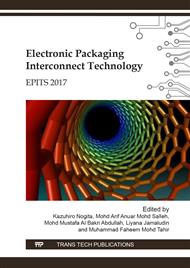[1]
A. Calik, M.S. Karakaş, Effect of heat treatment on the microstructure and mechanical properties of martensitic stainless-steel joints welded with austenitic stainless-steel fillers, Materiali in Tehnologije, 47(4) (2013) 403-407.
DOI: 10.1016/j.vacuum.2022.111440
Google Scholar
[2]
R. Sola, R. Giovanardi, P. Veronesi, G. Poli, Effect of quenching method on the wear and corrosion resistance of stainless steel AISI 420 (TYPE 30Kh13), Metal Science and Heat Treatment, 54(11-12) (2013) 644-647.
DOI: 10.1007/s11041-013-9564-1
Google Scholar
[3]
L.F. Alvarez, C. Garcia, V. Lopez, Continuous cooling transformations in martensitic stainless steels, ISIJ International, 34(6) (1994) 516-521.
DOI: 10.2355/isijinternational.34.516
Google Scholar
[4]
L.D. Barlow, M. Du Toit, Effect of austenitizing heat treatment on the microstructure and hardness of martensitic stainless steel AISI 420, Journal of Materials Engineering and Performance, 21(7) (2012) 1327-1336.
DOI: 10.1007/s11665-011-0043-9
Google Scholar
[5]
M.G. Minciună, P. Vizureanu, D.C. Achiței, N. Ghiban, A.V. Sandu, N.C. Forna, Structural Characterization of Some CoCrMo Alloys with Medical Application, Rev. de Chimie, 65(3) (2014) 335-341.
Google Scholar
[6]
G. Nemţoi, M.S. Secula, I. Creţescu, S. Petrescu, Rev. de Chimie, 57(10) (2007) 952-956.
Google Scholar
[7]
S. Petrescu, M.S. Secula, G. Nemtoi, I. Cretescu, Rev. de Chimie, 60(5) (2009) 462-467.
Google Scholar
[8]
G. Nemtoi, F. Ionica, T. Lupascu, A. Cecal, Chemistry Journal of Moldova. General, Industrial and Ecological Chemistry, 5(1) (2010) 98-105.
DOI: 10.19261/cjm.2010.05(1).10
Google Scholar
[9]
M. Sànchez, J. Gegori, M.C. Alonso, J.J. Garcia - Jareno, H. Takenouti, V. Vicente, Electrochemica acta, 52 (2007) 7634.
Google Scholar
[10]
S. Ningshen, U. Kamachi Mudali, G. Amarendra, Baldeo Raj, Corrosion Science, 51(2009) 322-329.
DOI: 10.1016/j.corsci.2008.09.038
Google Scholar
[11]
D.M. Gordin, T. Gloriant, G. Nemtoi, R. Chelariu, N. Aelenei, A. Guillou, D. Ansel, Materials letters, 59 (2005) 2936-2941.
DOI: 10.1016/j.matlet.2004.09.063
Google Scholar
[12]
G. Nemţoi, A. Ciomaga, T. Lupaşcu, Revue Roumaine de Chimie, 57 (9-10) (2012) 837-841.
Google Scholar
[13]
Qiang Guo, Jian-Hua Liu, Mei Yu, Song-Mei Li, Acta Metall. Sin. (Engl. Lett.), 28 (2) (2015) 139–146.
Google Scholar
[14]
J. O'M Bockris, Reddz A.K.N., Modern Electrochemistry, 2, New York, Plenum Press, (1970).
Google Scholar
[15]
D.A. Jones, Principles and prevention of Corossion, New York, Macmillan, (1992).
Google Scholar


